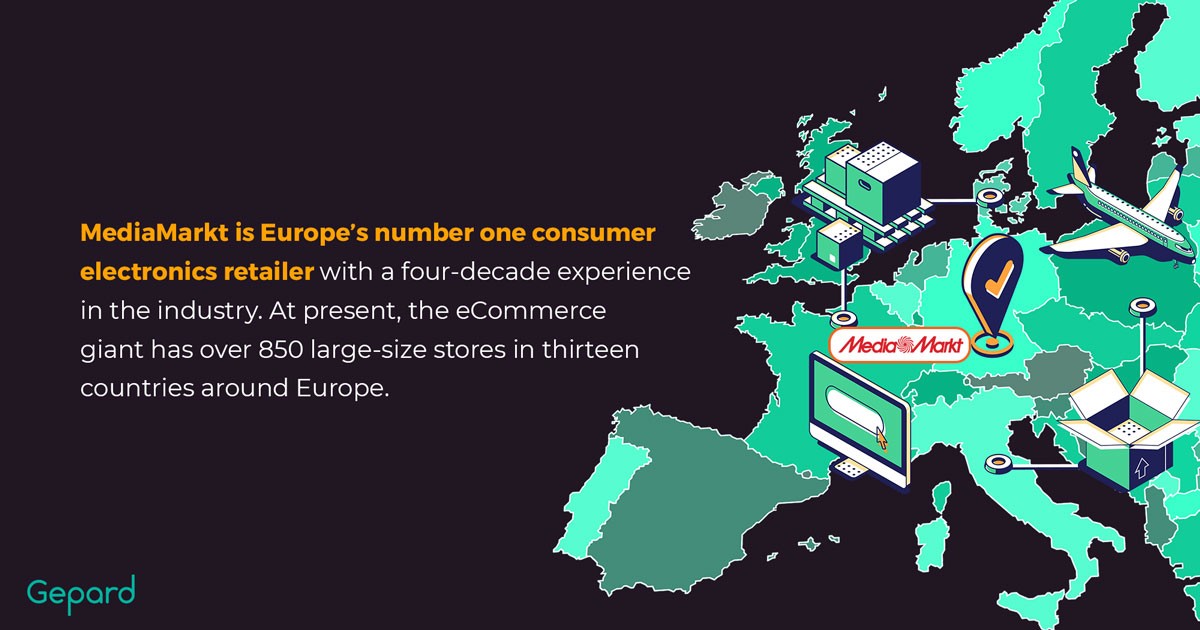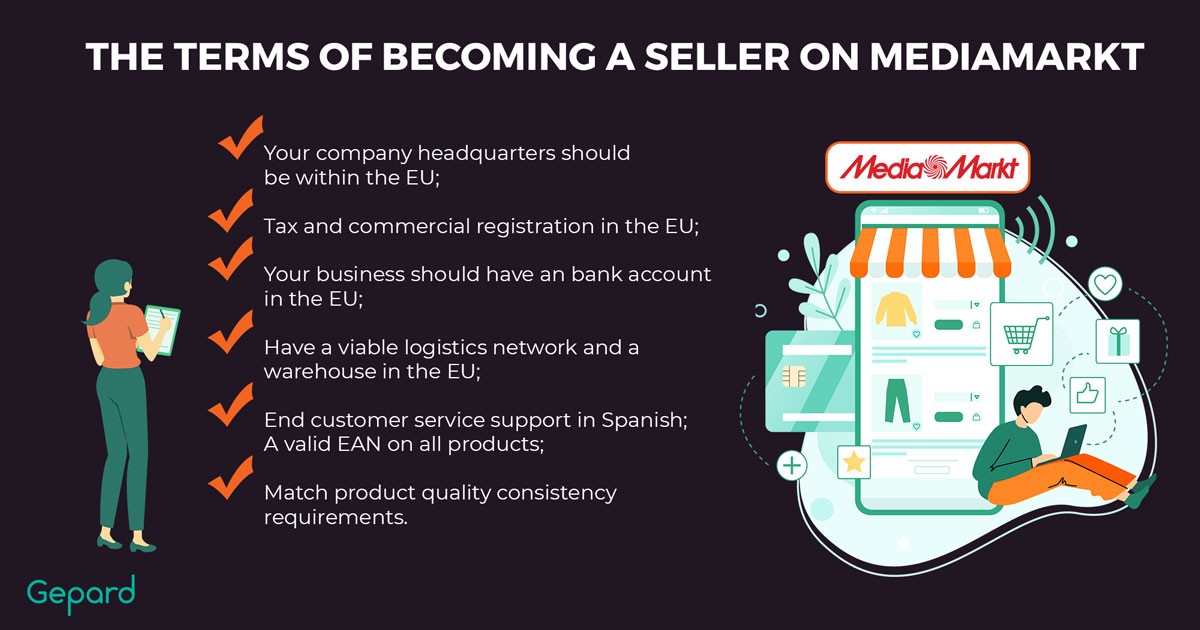Mediamarkt Marketplace: How to Sell On It?
MediaMarkt is a force to reckon with in the consumer electronics eCommerce industry. The leading European electronics mogul and home appliance giant leads the way through innovation, a customer-centric approach, and a wide range of customer and after-sales services.
Presently, the eCommerce giant has over 800 large-size stores in thirteen countries around the world. In this article, we are going to explore selling on MediaMarkt in-depth, revealing the benefits as well as the challenges and pitfalls brands, manufacturers, and retailers have to navigate to leverage the platform fully.
What Is Marketplace Integration
What Is MediaMarkt?
MediaMarkt is Europe’s number one consumer electronics retailer with a four-decade experience in the industry. With such a rich history, this business has seen it all and leverages an innovative approach to always stay one step ahead. It gives a customer-centric approach with complimentary after-sale services, making the portfolio more persuasive than ever.

Also, it is a one-stop-shop platform for all consumer electronics, including game consoles, TVs, stereo systems, coffee makers, phones, and tablets. Besides innovation and omnichannel experience, thus it offers a one-of-a-kind decentralized corporate structure. Each store under the brand’s umbrella is an independent entity. Owners retain up to a 10% stake to spearhead the “all business is local” motto. With this system, store owners vest more interest in the success of the business, just like in a sole proprietorship.
How To Start Selling On MediaMarkt Online
Selling on this electronic consumer platform puts you ahead of the competition. And getting started is no rocket science, even if you don’t have the Mediamarkt club card. Moreover, the process of updating stocks, products, and prices is seamlessly comfortable. Businesses and brands have multiple options of making connections. For instance, you can connect through an API interface, a CSV file, an Excel template, or back-office maintenance among many other options.
The user-friendly API interface makes it easy to track orders, manage shipments, and stay in communication with your customers throughout and after the buying process. Moreover, the program collaborates with multiple data service providers to harness a broader spectrum of integration capabilities. Some of the interfaces you can enjoy currently include Gepard, ChannelEngine, Plentymarkets, and EffectConnect.
The Terms & Conditions Of Becoming A Seller On MediaMarkt
The good thing about this solution is that users are not subject to any hidden costs, whatsoever. Everything is fair and transparent, with a €39 monthly fee. Users are also charged a flat-rate commission on every sale. However, the amount of commission varies with product categories. In addition, sellers can cancel their contract anytime with no fines or overhead costs.
You’ll need to meet the following requirements before selling on MediaMarkt:
- Your company headquarters should be within the EU;
- Undergo a complete tax and commercial registration in the EU;
- Your business should have an active bank account in the EU;
- Have a viable logistics network for delivering products to the end consumer;
- Have a warehouse in the EU for managing returns;
- End customer service support in Spanish (email and phone);
- A valid EAN on all products;
- Match product quality consistency as highlighted in the requirements guide.

Challenges & Opportunities Of Selling On MediaMarkt
Just like any other solution, MediaMarkt has its challenges as well.
- ‘Blind’ registration process
For one, the MediaMarkt doesn’t provide many details upon seller registration. You can only see detailed information when you complete the whole registration process and a representative from the company gets in touch with you.
- Absence of public API
Although there is an integrated API, it’s not available publicly. In other words, there is no API, which can affect connectivity and effective collaboration.
- Lack of integration support
Another challenge that users face is a missing developer’s portal. You will hardly find instructions on how to integrate the program with your store. This can present a lot of challenges for someone leveraging the solution for the first time. Typically, you would want your onboarding process to be as intuitive and well-guided as possible.
- Complex product taxonomy
MediaMarkt is a taxonomy-driven marketplace. Users have to comply with the taxonomy — the principle of classification—when uploading their goods. For instance, you have to meet various criteria for prices, quality levels, and underlying product descriptions. All these aim to promote order.
- Manual work with product datasheets
Users have to do tedious, manual work on datasheets before importing or exporting them. The process would be simpler with an integrated automated tool that enables in-bulk merchandise import/export, enrichment, and data validation.
On the flip side, it offers numerous opportunities not available in traditional buying & selling environments.
- Access to the defined location
For instance, brands and businesses have access to the chosen market in a particular area. This allows you to build a loyal customer base or expand your operations to foreign markets, such as Spain or Germany.
- Constant international growth
What’s more, the platform is always launching new markets, allowing you to scale rapidly without high overhead costs.
- Credible selling partner
You also get the opportunity to work with a solution that offers unparalleled trustworthiness and credibility. Remember, whichever company you partner with influences the outlook of your business and how customers perceive it.
Solving Marketplace Integration Puzzle
Businesses usually experience challenges when connecting to marketplaces. MediaMarkt is not an exception. Whether it’s data insecurity or incompatibility with third-party tools, you’ll always find a problem that limits your experience. Moreover, some don’t offer a plug-n-play solution for sellers. That means the programs don’t detect and configure hardware solutions automatically, which can be pretty frustrating.

Some of the solutions facing such challenges include eBay and OpenCart. Integrating extensions on eBay is quite complex for amateur sellers. Similarly, you need to be tech-savvy to sync your inventory with eBay.
Nevertheless, there is always a solution for solving the marketplace integration puzzle. For example, you can:
- Leverage Out-of-the-Box Integration Solutions
An out-of-the-box integration solution connects your store seamlessly to multiple markets. The solution should include marketplace tools for managing product info or data in all formats. It should also give you rapid listing updates and synchronization, and invoice updating. Remember, poor invoicing practices can result in accounting problems.
The pros of working with advanced integration solutions include unlimited access to technical support. However, you might need to pay premium rates to enjoy exclusive services.
- Custom Integration Services
Every business is unique and to improve conversions, creating a personalized consumer experience is imperative. Custom integration solutions, in this case, provide you with software that seamlessly unifies your business processes to the marketplace. Although costly, these solutions are entirely developed to match your specific business needs, elevating your selling experience.
- Marketplace API
Marketplace API connects various eCommerce applications and solutions, allowing sellers to use the information they gather on a single user interface. APIs streamline eCommerce processes, are scalable, and can be reused across various solutions. However, since it acts as a gateway between different applications, it is prone to hacking, compromising the security of your business.
- Build a Connector By Your Own
Since they are tailored to the specific needs of a business, self-built data connectors allow a high level of customization. Sellers can integrate as many end-points as they wish. However, building connectors from scratch is time-consuming. Also, since it requires tech-savviness, relying on in-house software developers may not suffice, probing the need to outsource to proficient developers knowledgeable on the preferred tech stack with appropriate eCommerce experience.
What If I Want to Sell On Multiple Marketplaces?
In such situations, you need to look for custom integration solutions. For example, one of the proven ways to start selling on multiple marketplaces and integrate content syndication is using PIM tools.
So, what is PIM for eCommerce?
Product Information Management (PIM) is an eCommerce solution that offers a centralized location where businesses can store product info from which other eCommerce channels can source. It is an excellent way for businesses to manage all the information they need to sell on multiple marketplaces from a single source of truth.
PIM technology standardizes data and facilitates integrations with various applications such as your inventory tracking software. Since it collects, updates, and distributes this information, it provides a personalized experience, improves data quality, and promotes seamless content management to various sales channels.
A robust PIM solution provides features that allow you to save time and money for strategic work, get rid of manual work, and reduce time-to-market.
Revamp your data flow, through automated adjustments to the required format. Leveraging data mapping techniques enables you to constantly push your goods at the right time and with precision.
Ensure your data are clean and consistent and save yourself from enormous data error costs. This groundbreaking tool validates data on reports, making sure there are no missing or incorrectly completed areas. In the same way, with a multi-tenant architecture, all your clients will be able to perform custom integrations, however, altogether share the core information management system.
Imagine multi-tenancy as a typical apartment building. While there are many flats inside, each with different designs and plans, they all have a single centralized administration, electricity, security system, as well as water sources.
Every tenant in the facility is more like a family of one or more users that lives in their own flat. Each apartment has a unique layout and interior. At the same time, all apartments are in the same building with a single centralized administration, security system, as well as sources of electricity and water. All these features collaborate to ensure the equal and easy distribution of product information.
How Gepard PIM Can Help Automate Data Exchange Between Mediamarkt (Or Any Marketplace Online) And Your Store
For manufacturers and brands, selling goes beyond registering on MediaMarkt or any other marketplaces online, posting merchandise, and hoping to capture the attention of retailers globally.
One of the best ways to succeed on online solutions is adapting your goods to their specific requirements and your target audience. Easier said than done, right? – Right!
Adjusting the data and maintaining compliance with each retailer’s standards and requirements is a significant challenge on eCommerce programmes. But not anymore!
Gepard is an innovative PIM platform, helping brands and manufacturers overcome challenges relating to merchandise data. Leveraging advanced data transformation capabilities and a syndication module, sellers can maintain quality merchandise info, regularly modify it according to specific needs, and smoothly push it across selling environments. In addition, the automation feature handles humdrum tasks, speeding up the sales cycle.
What’s Next?
Gepard can help brands and manufacturers integrate their existing systems with MediaMarkt to facilitate eCommerce product management. In turn, we can reduce time-to-market, help you reach a wider audience faster, and improve conversions. You can rest assured your brand will witness a significant boost in product performance and ensure a wholesome retail experience.
Connect with our dedicated specialists for more insights on product information management, how you can integrate it into MediaMarkt, and what value it brings to your business.






